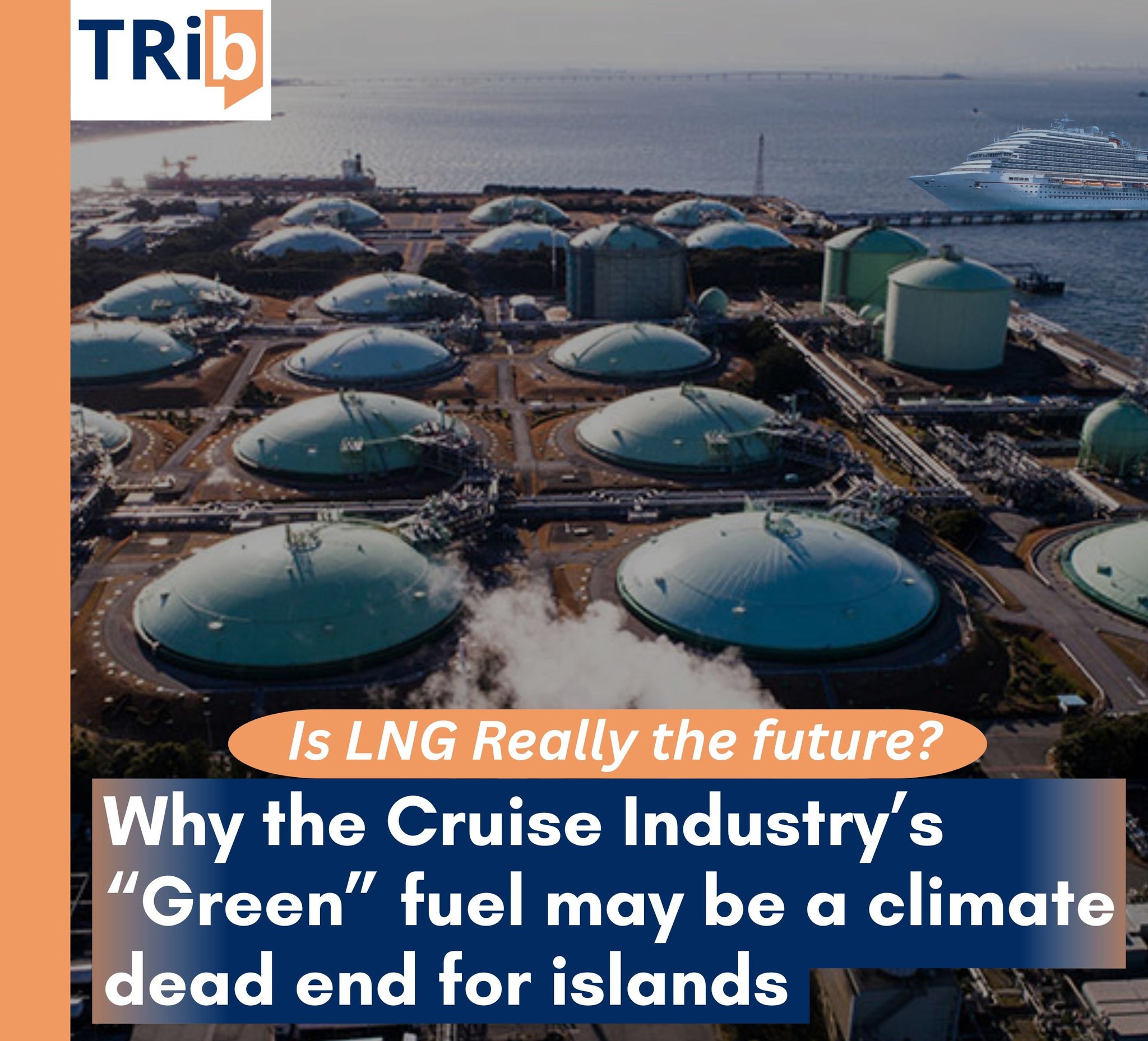NEW YORK--When Royal Caribbean unveiled the Icon of the Seas, the largest cruise ship ever built, the company hailed it as a climate-forward marvel. Powered by liquefied natural gas (LNG), the ship was framed as a step toward a cleaner future for the cruise industry. But climate experts say this narrative deserves a hard second look.
Despite its cleaner-burning profile compared to traditional marine fuels, LNG—primarily composed of methane, may be exacerbating the cruise industry's climate impact rather than solving it. Methane is a potent greenhouse gas, and its unintentional release across the LNG supply chain, a phenomenon known as “methane slip,” significantly undermines any perceived environmental benefits.
Island governments, especially in the Caribbean and Pacific, should be particularly cautious in endorsing LNG as a “green” solution. These are the countries most vulnerable to the effects of climate change: rising sea levels, stronger hurricanes, saltwater intrusion, and coastal erosion are already threatening lives and livelihoods. Yet by promoting LNG or embracing LNG infrastructure in tourism or energy policy, they risk accelerating the very crisis that endangers their future.
𝐌𝐞𝐭𝐡𝐚𝐧𝐞: 𝐓𝐡𝐞 𝐇𝐢𝐝𝐝𝐞𝐧 𝐓𝐡𝐫𝐞𝐚𝐭
The International Council on Clean Transportation (ICCT), a leading research organization on global transport emissions, has warned that LNG-fueled ships may emit more lifecycle greenhouse gases than ships running on marine gas oil, particularly due to methane leakage during production, transport, and combustion. Even small leaks of methane, which is more than 80 times more powerful than CO₂ over a 20-year period, can have devastating effects on global warming trajectories.
According to a January 2024 article in The Guardian, the Icon of the Seas emits 70–80% more greenhouse gases per trip than traditional ships when methane emissions are taken into account. The newspaper cited findings that Royal Caribbean’s LNG strategy “may be a form of greenwashing” if methane slip is not seriously addressed.
Similarly, Climate Change News reported in late 2023 that “the cruise industry is selling LNG as a climate solution, when in reality, it could lock in harmful emissions for decades.” Researchers there cited concern that promoting LNG risks delaying the necessary shift toward zero-emission technologies like green hydrogen or advanced biofuels.
𝐀𝐧 𝐈𝐧𝐟𝐫𝐚𝐬𝐭𝐫𝐮𝐜𝐭𝐮𝐫𝐞 𝐚𝐧𝐝 𝐈𝐧𝐯𝐞𝐬𝐭𝐦𝐞𝐧𝐭 𝐓𝐫𝐚𝐩
LNG’s requirements extend far beyond the engine room. Storage tanks must maintain the fuel at −160°C, requiring heavy-duty insulation and engineering. Ships must be dual-fuel capable, adding weight, reducing cargo/passenger space, and increasing construction costs.
What’s more, many ports around the world lack the infrastructure to bunker LNG safely and efficiently. A ship marketed as LNG-powered may end up relying on traditional diesel fuel for significant portions of its operation, undercutting its own climate claims.
As one maritime analyst told Ship Technology, “The cruise industry is investing heavily in a fuel that has a fast-approaching expiration date. The moment regulatory frameworks catch up with the science on methane, LNG could become a liability.”
𝐑𝐞𝐠𝐮𝐥𝐚𝐭𝐢𝐨𝐧 𝐈𝐬 𝐂𝐚𝐭𝐜𝐡𝐢𝐧𝐠 𝐔𝐩
That moment may be sooner than many in the cruise industry expect. The European Union, under its FuelEU Maritime initiative, is moving to require more accurate accounting of lifecycle emissions, including upstream methane leakage. If adopted globally, such policies could strip LNG of its current climate-friendly status.
“The cruise industry is at risk of investing in stranded assets,” said a clean shipping researcher from Transport & Environment, a European NGO focused on transport emissions. “By the time these LNG ships reach mid-life, they may already be outdated from a climate compliance standpoint.”
𝐀 𝐅𝐚𝐥𝐬𝐞 𝐒𝐞𝐧𝐬𝐞 𝐨𝐟 𝐏𝐫𝐨𝐠𝐫𝐞𝐬𝐬
Proponents argue that LNG still has a role in reducing particulate matter, sulfur oxides (SOx), and nitrogen oxides (NOx)—pollutants that harm human health and coastal air quality. While this is true, critics argue that climate change—not just local pollution—is the defining challenge of the next generation, and methane leakage outweighs the near-term gains.
Furthermore, cleaner alternatives are emerging. Cruise companies such as Hurtigruten and MSC are experimenting with methanol, battery-electric propulsion, and hydrogen technologies. These options, while not yet widespread, point to a future that aligns better with international climate goals.
𝐀 𝐅𝐮𝐞𝐥 𝐟𝐨𝐫 𝐭𝐡𝐞 𝐏𝐚𝐬𝐭, 𝐍𝐨𝐭 𝐭𝐡𝐞 𝐅𝐮𝐭𝐮𝐫𝐞
In the face of mounting climate urgency, LNG no longer looks like a bridge fuel, it looks like a detour. As scientists, environmental groups, and even regulators increasingly point out, the cruise industry’s embrace of LNG risks locking in emissions at a moment when the world needs dramatic reductions.
LNG is not a neutral choice. It is a fossil fuel with a powerful short-term warming effect, and the policies and investments surrounding it have global consequences. If methane emissions continue unchecked, the climate clock for small island states may run out even faster.
For cruise lines, investing in LNG may offer temporary relief from air pollution regulations, but at the expense of long-term sustainability and climate responsibility. For island nations, supporting LNG could unintentionally help lock in a warming trajectory that threatens their very survival.
The industry, and its host destinations, must ask a difficult but necessary question: Is LNG truly a steppingstone to zero emissions, or is it a shiny distraction from the real work of climate action?
Careful research and consideration must be provided.
𝘚𝘰𝘶𝘳𝘤𝘦𝘴:
- 𝘛𝘩𝘦 𝘎𝘶𝘢𝘳𝘥𝘪𝘢𝘯, “𝘉𝘪𝘨𝘨𝘦𝘴𝘵, 𝘉𝘢𝘥𝘥𝘦𝘴𝘵: 𝘉𝘶𝘵 𝘐𝘴 𝘐𝘵 𝘵𝘩𝘦 𝘊𝘭𝘦𝘢𝘯𝘦𝘴𝘵?” (𝘑𝘢𝘯𝘶𝘢𝘳𝘺 2024)
- 𝘊𝘭𝘪𝘮𝘢𝘵𝘦 𝘊𝘩𝘢𝘯𝘨𝘦 𝘕𝘦𝘸𝘴, “𝘛𝘩𝘦 𝘊𝘳𝘶𝘪𝘴𝘦 𝘐𝘯𝘥𝘶𝘴𝘵𝘳𝘺 𝘚𝘢𝘺𝘴 𝘓𝘕𝘎 𝘐𝘴 𝘢 𝘊𝘭𝘪𝘮𝘢𝘵𝘦 𝘚𝘰𝘭𝘶𝘵𝘪𝘰𝘯. 𝘐𝘵’𝘴 𝘕𝘰𝘵.” (𝘚𝘦𝘱𝘵𝘦𝘮𝘣𝘦𝘳 2023)
- 𝘐𝘯𝘵𝘦𝘳𝘯𝘢𝘵𝘪𝘰𝘯𝘢𝘭 𝘊𝘰𝘶𝘯𝘤𝘪𝘭 𝘰𝘯 𝘊𝘭𝘦𝘢𝘯 𝘛𝘳𝘢𝘯𝘴𝘱𝘰𝘳𝘵𝘢𝘵𝘪𝘰𝘯 (𝘐𝘊𝘊𝘛), 𝘮𝘶𝘭𝘵𝘪𝘱𝘭𝘦 𝘱𝘰𝘭𝘪𝘤𝘺 𝘣𝘳𝘪𝘦𝘧𝘴
- 𝘚𝘩𝘪𝘱-𝘛𝘦𝘤𝘩𝘯𝘰𝘭𝘰𝘨𝘺.𝘤𝘰𝘮, “𝘛𝘩𝘦 𝘗𝘳𝘰𝘴 𝘢𝘯𝘥 𝘊𝘰𝘯𝘴 𝘰𝘧 𝘓𝘕𝘎 𝘊𝘳𝘶𝘪𝘴𝘦 𝘚𝘩𝘪𝘱𝘴”
- 𝘛𝘳𝘢𝘯𝘴𝘱𝘰𝘳𝘵 & 𝘌𝘯𝘷𝘪𝘳𝘰𝘯𝘮𝘦𝘯𝘵, 𝘌𝘜 𝘤𝘭𝘦𝘢𝘯 𝘴𝘩𝘪𝘱𝘱𝘪𝘯𝘨 𝘢𝘥𝘷𝘰𝘤𝘢𝘤𝘺 𝘮𝘢𝘵𝘦𝘳𝘪𝘢𝘭𝘴
Join Our Community Today
Subscribe to our mailing list to be the first to receive
breaking news, updates, and more.






%20(412%20x%20570%20px)%20(412%20x%20340%20px).jpg)